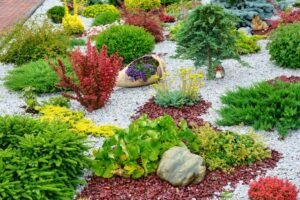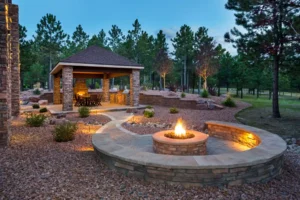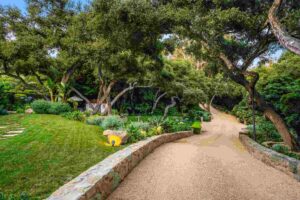Rock landscaping is an appealing and practical way to enhance any outdoor space, whether it’s a small front yard or a sprawling backyard. By incorporating various types of rocks and stones into your landscaping design, you can create a low maintenance, eco-friendly environment that’s visually stunning and resilient. In this article, we’ll explore rock landscaping ideas, discuss its benefits, and guide you through the types of rocks and techniques for creating your own unique landscape.
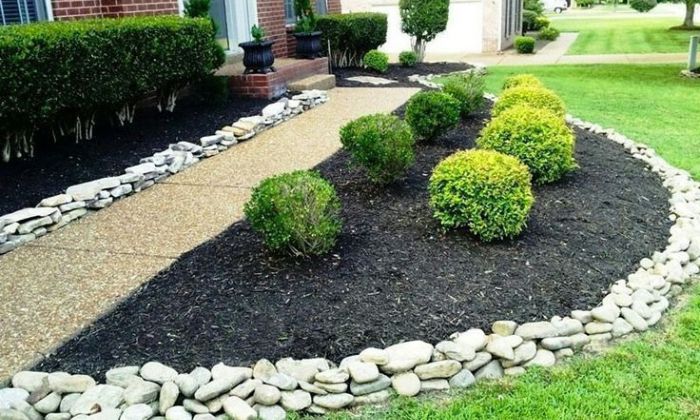
Benefits of Rock Landscaping
Rock landscaping offers a range of benefits that make it a smart choice for many homeowners.
Low Maintenance
Rock landscaping offers a low maintenance solution, ideal for those seeking an easy-care garden. Unlike traditional gardens that need frequent watering, pruning, and fertilizing, rock gardens require minimal effort. This style is especially suited to drought-prone areas, as rocks help retain soil moisture and reduce the need for watering. Additionally, rocks discourage weeds and eliminate the need for fertilizers, making it both eco-friendly and time-saving. Rock landscaping provides a sustainable, attractive option for those wanting a beautiful yard without the usual gardening demands.
Durability
Landscaping rocks are highly durable, and capable of withstanding extreme weather, from intense sun to heavy rainfall. This resilience means rocks won’t easily degrade or break down, allowing them to maintain their appearance and function over many years. Once installed, they require minimal upkeep and rarely need to be replaced, making them a long-lasting and cost-effective choice for landscaping. Their ability to handle varying climates and conditions makes rocks an ideal solution for outdoor projects that demand reliability and durability over time.
Aesthetic Appeal
Rock landscaping enhances outdoor spaces with a natural, earthy appeal that suits many design styles. Rocks introduce texture, depth, and structure, giving your yard a visually engaging look. By using various rock types, you can create contrasts and focal points that add sophistication and balance. This approach works well with both modern and traditional garden designs, offering a low maintenance yet striking aesthetic that integrates seamlessly with plants, water features, and paths. The versatility of rocks allows for creative arrangements, making your outdoor area visually interesting and uniquely tailored to your personal taste.
Eco-Friendly
Rock landscaping is an eco-friendly option that conserves water and reduces the need for fertilizers or pesticides. Rocks require no watering, unlike traditional grass or flower beds, significantly lowering water use. They also provide a durable ground cover that helps prevent soil erosion, keeping landscapes intact even in heavy rain. Additionally, rock landscaping creates a sustainable, low maintenance environment by limiting weed growth and eliminating chemical treatments, which can harm local ecosystems. This type of landscaping offers an attractive, environmentally responsible alternative that supports soil health while reducing resource consumption.
Types of Rocks for Landscaping
Choosing the right rocks for landscaping is essential to achieving your desired look. Here are some popular types:
Gravel
Gravel is a cost-effective, versatile material for landscaping. It’s commonly used for pathways, garden beds, and ground cover, adding both function and aesthetic appeal. Available in various sizes and colors, gravel allows for customization to suit different landscaping styles and needs. It’s easy to maintain, provides good drainage, and can help prevent weed growth. Gravel’s affordability and adaptability make it an ideal choice for enhancing outdoor spaces while staying within budget. Its natural look also complements many landscape designs, making it a practical and attractive solution for a range of outdoor projects.
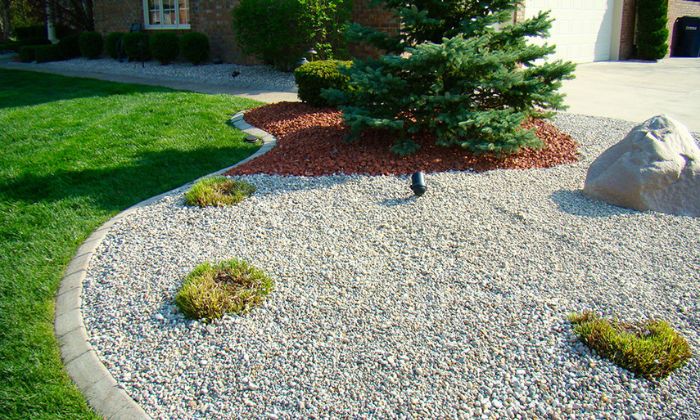
River Rocks
River rock landscaping adds natural beauty and rustic charm to outdoor spaces. These smooth, rounded stones work well for borders, creating natural-looking dry riverbeds, and as decorative accents around plants. River rocks come in various sizes and colors, blending seamlessly with the landscape to create a calming effect. They’re durable and require minimal upkeep, making them ideal for garden beds, pathways, or surrounding water features. River rocks also help with drainage and can prevent weed growth, making them both functional and visually appealing in gardens, yards, or pathways.
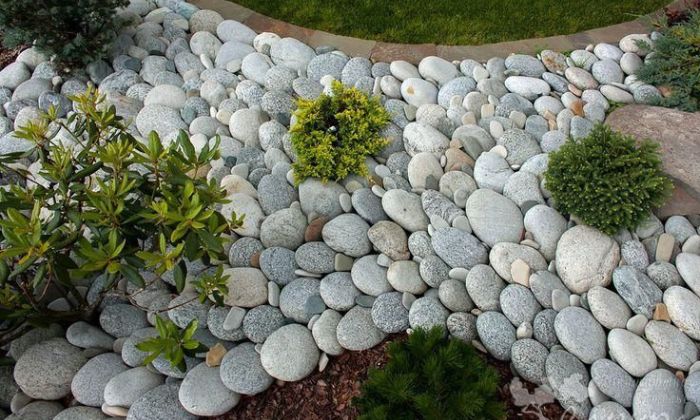
Lava Rocks
Lava rocks are lightweight, durable, and come in rich, vibrant colors, making them a popular choice for landscaping. Their porous texture allows them to retain moisture, making them ideal for water efficient gardens, especially in dry climates. These rocks are often used as mulch to reduce weed growth and keep soil temperature stable. Their unique appearance adds a striking color contrast to landscapes, enhancing the aesthetic appeal of gardens, pathways, and decorative features. Lava rocks are also low maintenance and long lasting, making them a practical and decorative choice for sustainable landscaping projects.
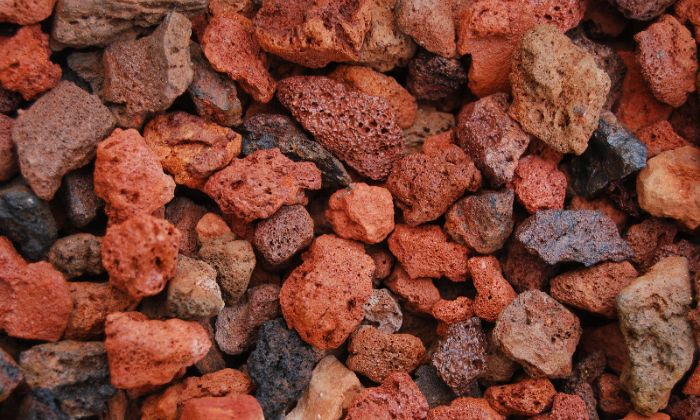
Flagstones
Flagstones are flat, naturally occurring stones commonly used for creating walkways, patios, and steps. Known for their irregular shapes, they provide a rustic and natural aesthetic, making them a popular choice for outdoor spaces. These versatile stones can be used to form pathways, garden paths, or even as stepping stones in landscaping projects. Flagstones come in various types of stone, including slate, limestone, and sandstone, each offering different colors and textures to suit various design preferences. Their durability and ability to blend into natural surroundings make them an excellent choice for outdoor flooring.
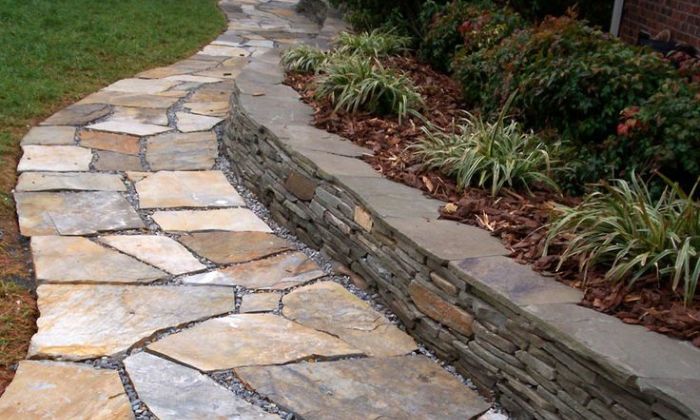
Pebbles and Crushed Stones
Pebbles and crushed stones are versatile materials commonly used for landscaping, particularly for creating rock borders and edging. They work well as ground cover in flower beds, around trees, or in rock gardens, providing both functionality and aesthetic appeal. Pebbles offer a smooth, polished look, while crushed stones create texture and contrast. These materials help with drainage, suppress weed growth, and add visual interest. Ideal for softening the landscape, they complement plants and other natural features, enhancing the overall beauty of outdoor spaces. They’re an excellent choice for adding a refined yet natural touch to any garden or yard design.
Popular Rock Landscaping Ideas
Rock landscaping offers endless possibilities for designing beautiful, functional outdoor spaces. Here are some popular ideas to consider:
Rock Gardens
Rock gardens are a beautiful way to enhance your yard’s aesthetic by combining different rock types and sizes to create a natural, rugged landscape. These gardens often feature low maintenance plants, such as succulents, cacti, and alpine flowers, that thrive in well drained soil and require minimal care. The use of rocks adds texture, color, and contrast, making the garden visually striking. Rock gardens are also ideal for areas with poor soil or drought-prone climates, as the plants are well suited to withstand dry conditions. Overall, they offer a sustainable and low-maintenance landscaping option for any outdoor space.
Rock Pathways and Walkways
Rock pathways and walkways are both functional and visually appealing additions to any garden or outdoor space. By using materials like flagstones or gravel, these paths can provide a clear route through your landscape, making it easier to navigate. They also enhance the overall aesthetic, adding natural beauty and structure to your garden. Whether winding through flower beds or connecting different areas of the yard, rock pathways create an inviting atmosphere for guests while also offering practical benefits like durability and easy maintenance. They’re a timeless feature that blends seamlessly with nature.
Water Features
Water features, like ponds or small waterfalls, enhance the tranquility of a yard by introducing soothing sounds and visuals. A pond surrounded by river rocks creates a peaceful, natural aesthetic, while a waterfall cascading over large landscaping rocks adds movement and interest. These features work harmoniously with river rocks, complementing their smooth, natural texture and creating a flowing, organic look. The combination of water and rocks brings balance, promoting relaxation and a calming ambiance in outdoor spaces. Water features also attract wildlife, enriching the garden’s ecosystem and enhancing its beauty.
Rock Mulch
Rock mulch is a durable alternative to organic mulch, made from materials like lava rocks, gravel, and pebbles. It helps retain moisture in the soil by reducing evaporation, making it beneficial for plant health. Additionally, rock mulch inhibits weed growth, minimizing the need for constant maintenance. Its aesthetic appeal adds a clean, polished look to landscaping, creating a visually pleasing environment. Unlike organic mulch, rock mulch doesn’t decompose, making it a long-lasting choice for gardens and flower beds. It’s an ideal solution for areas that require low maintenance, moisture retention, and enhanced curb appeal.
Retaining Walls
Retaining walls made with large landscaping rocks are an effective solution for supporting sloped terrain and preventing soil erosion. They create a stable structure, allowing for the development of terraced landscapes or raised garden beds. These walls not only offer functional support but also enhance the aesthetic appeal of a yard by adding dimension, texture, and natural beauty. By using durable stones, they can withstand weathering, making them a long-lasting addition to any outdoor space. Retaining walls serve both practical and decorative purposes, transforming a simple garden into a visually dynamic and organized landscape.
Fire Pit Areas
Creating a fire pit area with stones in your backyard adds both functionality and charm to your outdoor space. Stones can be used to build the pit itself, providing a sturdy and durable structure. Surrounding the fire pit with gravel or lava rocks enhances safety by preventing the spread of fire and helps with heat distribution. Additionally, these materials make cleanup easier, as they absorb ash and debris, reducing maintenance. A well-designed fire pit area offers a cozy and inviting spot for gatherings, allowing you to enjoy warmth and ambiance while spending time outdoors.
Choosing the Right Rocks for Your Landscape
Choosing the right rocks for your landscape depends on your yard’s aesthetic, climate, and functional needs. For a desert landscape, opt for warm-toned stones and drought-resistant plants. Flagstones are ideal for creating sturdy, attractive pathways. River rocks work well around water features, offering a smooth, natural appearance. Each type of rock serves a specific purpose, whether for texture, color, or durability, so consider both the look and function of the space when making your selection. Matching the right rocks with plants and features enhances the overall design, ensuring harmony and practicality.
DIY vs. Hiring a Professional for Rock Landscaping
DIY rock landscaping can be a rewarding project for those with the necessary skills and time. However, hiring a professional ensures a higher-quality outcome with expert guidance on rock placement, soil compatibility, and proper drainage. Professionals have the experience to create aesthetically pleasing designs and ensure the installation is durable and functional. While DIY offers cost savings, the expertise of a professional can lead to more precise and long-lasting results. Ultimately, the decision depends on your confidence, budget, and desire for a flawless, low maintenance landscape.
Maintenance Tips for Rock Landscaping
Even though rock landscaping is low-maintenance, a little upkeep can keep it looking fresh and vibrant.
Preventing Weeds: Weeds can still grow between rocks, especially in gravel and pebble areas. Using landscape fabric beneath the rocks and adding a layer of sand can help prevent weed growth.
Cleaning Rocks: Over time, rocks can accumulate dirt, debris, and algae. You can clean them with a hose or use a mild soap solution and scrub brush to keep rocks looking pristine.
Refreshing Rock Beds: Adding a fresh layer of pebbles, gravel, or other decorative landscaping stone can brighten up rock beds and enhance their appearance.
Cost of Rock Landscaping
The cost of rock landscaping varies based on the type and amount of rock used, as well as the size of the area. While gravel and pebbles are generally more affordable, large landscaping rocks and flagstones tend to be more expensive. Additionally, professional rock landscaping installation can add to the cost but often ensures a higher-quality, long-lasting design.
Why Choose Us?
At Lakota Design Group, we specialize in eco-friendly and aesthetically pleasing rock landscaping solutions. Our experienced team helps clients choose the right types of landscaping rocks, designs custom rock features, and installs them with precision. Whether you’re looking for a full rock garden or subtle rock borders and edging, we’re here to bring your vision to life with expert guidance and high-quality materials.
Conclusion
Rock landscaping is a beautiful, durable, and eco-friendly choice that adds a natural appeal to any yard. From rock gardens to fire pit areas, there are endless ways to incorporate rock features into your landscape. By choosing the right types of rocks, deciding on DIY or professional help, and following simple maintenance tips, you can create a stunning rock landscape that will enhance your outdoor space for years to come. Whether you’re designing a rock landscaping plan for a large backyard or a small front yard, there’s a solution that’s perfect for your needs. Embrace the durability, versatility, and beauty of rock landscaping to transform your yard today.


